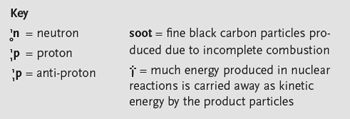Reaction Worksheet
Wood and fossil fuel reactions require oxygen for combustion to unleash the chemical energy stored in the fuel. The energy given off by these reactions, which is expressed in electron volts, is the energy released per molecule of fuel burned. An electron volt is an exceedingly small unit equal to 1.6 x 10-19 joule. (One joule is the amount of energy gained by a golf ball if it falls 2.2 meters.) The subscripts refer to the number of atoms of each element in the compounds. These equations are not balanced. Wood (cellulose) [C6H10O5]n ⇒ CO2 + H2O + soot + E (25 eV) Coal C + some S + O2 ⇒ SO2 + CO2 + soot + E (2.5 eV) Natural Gas (methane) CH4 + O2 ⇒ CO2 + H2O + E (9.2 eV) Gasoline (octane) C8H18 + O2 ⇒ CO2 + H2O + soot + E (66 eV)
Nuclear reactions require mechanisms other than combustion with oxygen to unlock their energy. For fission reactions, an unstable nucleus must capture a neutron before it splits into pieces and releases its energy. In nuclear fusion, particles need to be squeezed very tightly together with high temperature and pressure. Fusion occurs naturally in the core of the sun because the temperature there is 10 million degrees F and the pressure is incredibly high! In all nuclear reactions, it is the nucleus that changes in some way, one atom at a time. The numbers you see represent the total number of protons and neutrons in each nucleus or particle. Nuclear Fission Nuclear Fusion Photon Drive Reaction Some scientists have considered the possibility that a photon drive, which would operate according to the principles of E = mc2, could someday power spaceships. In particle accelerators on Earth, electrons have been observed colliding with anti-electrons (called positrons). When they collide, the particles disappear and energy in the form of gamma rays appears with energy equal to the mass of both particles, as predicted by E = mc2. In a hypothetical photon drive, protons and anti-protons would be used (being almost 2,000 times more massive than electrons, they would provide more energy). If a stream of protons could be made to collide with a stream of anti-protons, tremendous amounts of energy would be emitted, and gamma rays would shoot out the back of the rocket. The reaction would look like: 
|